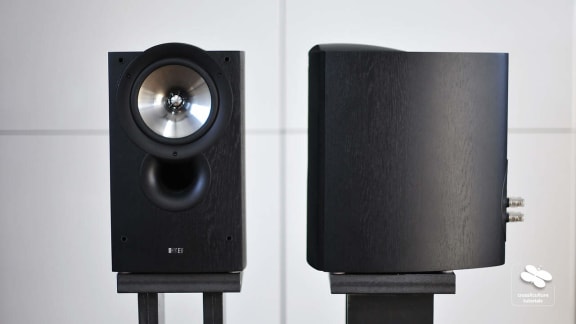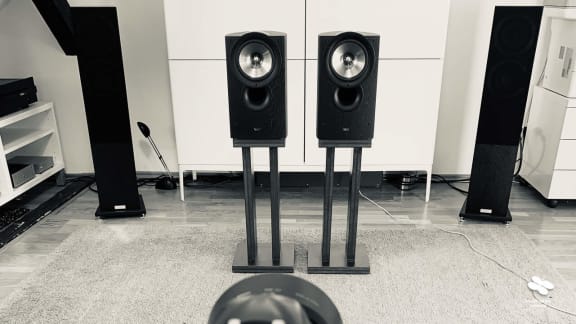KEF iQ30
Published: 23/08/2020
Manufacturing date: 2008
Author: Karsten Hein
Category: Gear & Review
Tag(s): Loudspeakers
Where do I begin? Perhaps best with an apology. Because, up until this point, no other speakers had captivated my attention and imagination more than these little bookshelves. And, in my attribution of positive and negative qualities to these loudspeakers, I may not always have been fair. It actually took me quite some time to find this out, and, in the end, it took the whole journey to get to the truth of things.
We had originally bought the KEFs as unobtrusive bookshelf speakers to play background music in our home office. This was well before I began contemplating to set up a second audiophile system to use when the kids where blocking our main listening room. As usual,I had studied reviews on entry level bookshelves that punched above their weight, and KEFs were mentioned repeatedly in this context.
In our office they had to replace some ageing Denon bookshelves that were left over from my old F-07 midi system. Driving these was an entry level Rotel preamp and amplifier combo rated at 2x 60 watts. The match was actually pretty decent in retrospective, as the Japanese combo had been designed with the affiliated Bowers & Wilkins in mind and is said to be following the philosophy of ‘British sound’. This, to my understanding, is characterised by accuracy, tonal balance, and a warm midrange.
While the Denons with their soft dome tweeters had been forgiving of flaws and therefore easy to integrate, the KEFs immediately revealed the sonic weakness of our cheap glass and aluminium speaker stands. Hence, we replaced the stands with a simple DIY design (using 4 cm MDF boards) and immediately noticed a shift from a harsh and technical sound towards a more pleasing and natural performance.
Another aspect revealed by the KEFs was the lack in bass response from the listening room. Our office is situated under the roof of the building and has many acoustic disadvantages: slanted gypsum walls all around that absorb much of the lower frequencies, lots of hard furniture surfaces that reflect higher frequencies, and an extensive room depth of 13 meters with the listening position located at just 2.5 meters from the speakers.
In my attempt to make the KEFs sound well-balanced, I brought in a range of preamplifiers and amplifiers, spanning from Rotel, via Hafler, to Harman Kardon. But the KEFs, to various degrees, remained harsh and bright sounding. I looked at the Uni-Q driver’s sharply pointed wave guides and could not help but wonder whether KEF had somehow got them wrong. Just like I had found my earlier Canton Ventos to have accentuated highs, which, as I later read in a test, actually turned out to be true.
Unable to get the iQ30s balanced in our office, I gave them to my brother for listening and switched to Tannoy DC 6t tower speakers instead. With an additional dedicated bass driver, the Tannoys offered more direct bass punch and sounded more balanced at short distance. Yet, on listening to the new speakers for longer, I realised that they, too, were struggling with the size and structure of the room.
Last week, I received the KEFs back from my brother. And—as during their absence I had started wondering if there was not something I had missed in setting them up—this time I decided not to take them to the office upstairs but rather to hook them up in our main listening room. To be honest, my expectations were not too high, as their rivals downstairs are not some old Denon bookshelves but rather the formidable Martin Logan SL3 electrostatic speakers.
I started out by playing a few songs on the Martin Logans. Jazz and Folk that I know well and enjoy listening to. Then I switched to the iQ30s, half expecting to have a big laugh. Surprisingly, this is not at all what happened. The KEFs set in at similar volume and almost identical sonic characteristic, so that at first, I looked over at the Martin Logans in disbelief. With the tweeter on axis and the wave guides to cast the highs deeply into the room, the KEFs displayed a similar energy and authority when setting the stage.
The SL3s strength lies in the accuracy and subtlety of voices, the iQ30s play voices well, but do not reach that same level of subtlety and intimacy. And yet, they come very close. If the Tannoys love piano keys, the KEFs caress the guitar. Nils Lofgren’s playing was thrust into the room much like I am used to from listening to the Martin Logans. Notes linger a little shorter on the KEFs than on the SL3s, which is no wonder considering the exceptional lightness of the Martin Logan’s Mylar membrane.
The KEFs now sound balanced in our main listening room. None of the former harshness is still present, so that listening for long hours is now highly enjoyable. Bass is full and present and at times even punchier than on the SL3s. However, when it comes to playing very low notes, these are still present on the Martin Logans and simply missing on the KEFs. This should not come as much of a surprise, considering the 30 cm woofer size on the SL3s as opposed to a small 16 cm full range speaker on the iQ30.
The KEFs present a wonderful stage and—like the Martin Logans—can play loud as well, creating a wonderful live atmosphere. The Martin Logans can play louder, of course, but personally I never listen to music at volumes where this would really matter. Considering the size of the KEFs, their ability to fill the room is a respectable. Doing so with accuracy and authority to take on much lager and more expensive floor standing speakers is incredible. Hence, my apology. When the KEFs did not perform well at first, it was obviously not a design flaw of the speakers. It was the room.
Specifications
- Frequency response: 45 - 40000 Hz
- Sensitivity: 89 dB
- Impedance, average: 8 ohms
- Crossover frequency: 2500 Hz
- Recommended power: +15 Watts RMS
- Weight: 6.45 kg
- Dimensions: 36.5 cm x 22.0 cm x 32.7 cm
- Country of manufacture: China
- Year(s): 2008





